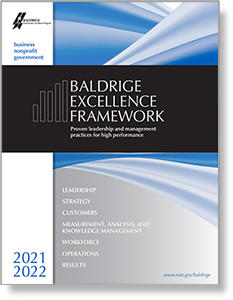Blogrige
The Official Baldrige Blog
Reach New Heights of Excellence, with Help from Humanity’s Best Friend

While I was reminiscing about National Take Your Dog to Work Day, a light-hearted conversation with colleagues led me to ponder how our furry friends might actually inspire people to reach new heights of excellence. But what business insights can we possibly gain from creatures who spend at least 50% of their day sleeping and loafing around?
All kidding aside, the question holds relevance for the Baldrige community. In fact, the notion that dogs have much to teach us about the elements of success and leadership has been popularly explored by experts in organizational psychology, leadership, communication, human resources, business administration, and other fields. Following are a few valuable takeaways that tie in with the Baldrige Excellence Builder® (available for free download), which is based on the Baldrige Excellence Framework® and its Criteria for Performance Excellence®.
Stay Hungry for “More”
Dogs often possess a strong sense of duty; dogs also are often hungry for more. They want more treats (no surprise!), more ear rubs, more play time … and more all-around goodness! In a similar vein, excellence-driven organizations don’t complacently rest on yesterday’s wins; they create an invigorating culture of more. That is, a culture of innovation that inspires the workforce to think outside the box, be open to change, take action, identify opportunities for improvement, and continuously improve their results (category 7 of the Baldrige Criteria).
However, in order to move forward and enjoy more success, having an action plan that aligns to your organization’s vision and mission is key. As explained in the Baldrige Excellence Builder®, action plans are “specific actions that your organization takes to reach its strategic objectives”—i.e., “the aims or responses that your organization articulates to address major change or improvement, competitiveness or social issues, and business advantages.” Action plans also “specify the resources committed to and the time horizons for accomplishing the plans.”
Lead with Love and Humility
Dogs often exude love and humility, which are correlates of productive work environments. In fact, many success factors, such as a team’s energy, contentment, and creativity; and the ability to attract satisfied, loyal customers (category 3 of the Baldrige Criteria) are contingent on leaders' ensuring that others feel valued, appreciated, and respected.
Famed dog behaviorist Cesar Millan’s research may even lead one to draw interesting analogies between being a pack leader and a people leader, in which calm–assertive energy, affection, and respect are also qualities that nurture engaged teams and drive great work.
Build Trust through Active Listening
The quality of your communication impacts your work relationships and performance on many levels. Dogs are quick to teach us this lesson, too, when we fail to recognize the signals they are sending us. As Nobel laureate Orhan Pamuk once said, "Dogs do speak, but only to those who know how to listen." Being attentive to their vocalization and gestures reveals important information about how they’re feeling (e.g., happy, alert, anxious, fearful, vulnerable, angry, playful, and so on), while helping us to respond more effectively and earn their trust.
Similarly, the way you interact and communicate with colleagues and employees is one of the greatest determinants of your success. Even if you’re naturally blessed with the gift of gab, it’s even more important do the listening and be the person with whom others love to talk. However, “just keeping quiet and nodding isn’t enough,” warns best-selling author Eric Barker, in an article for Barking Up the Wrong Tree.
It’s key that you actively listening to others—not only to the words being spoken, but also for their meaning; and not only to what is being said, but also how it’s being said (verbally and nonverbally). Strategies such as “mirroring, paraphrasing, and labeling” can also help you keep the communication strong, Barker suggests.
These are vital steps in building trust: the foundation on which every prosperous relationship—and every organization’s financial performance—is built. In an article for Harvard Business Review, internationally renowned business leaders Stephen Covey and Douglas Conant explained:
“Your ability to build trust has a profound effect on business results because trust affects two measurable outcomes: speed and cost. When trust goes down (in a relationship, on a team, in an organization, or with a partner or customer), speed goes down and cost goes up. This is … a ‘low-trust tax.’ The inverse is equally true: when trust goes up, cost goes down, and speed goes up resulting in a ‘high-trust dividend.’ These trust taxes and dividends are real and essential for leaders to understand as they develop their trust-building competence.”
For more guidance on establishing trusting, effective, and cooperative work environments, consult category 5 of the Baldrige Criteria.

Baldrige Excellence Framework®
The Baldrige Excellence Framework has empowered organizations to accomplish their missions, improve results, and become more competitive. It includes the Criteria for Performance Excellence, core values and concepts, and guidelines for evaluating your processes and results.
Purchase your copy today!
Available versions: Business/Nonprofit, Education, and Health Care




